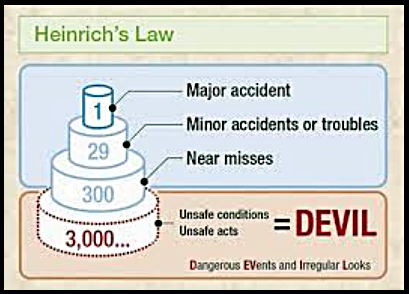고급자를 위한 이슈영어
하인리히 법칙
하인리히 법칙이 궁금하시죠?
일찍이 촌철살인의 대가인 마크 트웨인은
"우리는 그 일이 일어날 것이라는 사실을 모르기 때문이 아니라,
그런 일이 일어나지 않을 것이라는 믿음으로 인해서 위험에 처하게 된다"는
명언을 남긴 적이 있습니다.
세월호 같은 대형사고 한 번에 모든 것들이 무너져서
개인 혹은 기업 등 여러 가지로 피해를 입게 됩니다.
예전에는 재수가 없어서 속수무책으로 당하는 것이 재해라고 생각했지만,
최근에는 하인리히 법칙- “예고 없는 사고 없다.” 라는 법칙이 이슈가 되면서
많은 사람들이 세월호 사건에 분노하고 안타까워합니다.
이런 대형사고가 일어나려면, 이 보다 작은 사건이나 사고가 약 29건,
일어날뻔하거나 사소한 사건이나 사고가 약 300건이 일어난다고 해서 1 : 29 : 300 이라고도 불립니다.
사고와 재해의 발생을 과학적 통계로 밝혀놓은 하인리히 법칙에 대해서 알아보도록 하겠습니다.

히
Herbert William Heinrich (1886- June 22, 1962 ) was an American industrial safety pioneer from the 1930s.
*industrial safety pioneer : 산업안전의 선구자
He was an Assistant Superintendent of the Engineering and Inspection Division of Travelers Insurance Company when he published his book Industrial Accident Prevention, A Scientific Approach in 1931.
* Superintendent :감독관 / 책은 1931년에 출간 되었고 그 당시의 직책이 나옵니다.
One empirical finding from his 1931 book became known as Heinrich´s Law: that in a workplace, for every accident that causes a major injury, there are 29 accidents that cause minor injuries and 300 accidents that cause no injuries.
* empirical : 경험에 의거한, 실증적인.
finding – 결과물, 연구결과. / be known as -: ~로써 알려지다
Because many accidents share common root causes, addressing more commonplace accidents that cause no injuries can prevent accidents that cause injuries.
*공통의 뿌리(원인)을 가진다. / 평범한 사고
Heinrich´s work is the basis for the theory of Behavior-based safety,
which holds that as many as 95 percent of all workplace accidents are caused by unsafe acts.
* work 는 여기서는 저작 또는 이론. /
행동중심 안전 활동 – 약 95%의 작업장 사고가 안전하지 못한 행동에 의해서 야기된다.
/ holds – 담고 있다. 내용으로 하다. 정도로 보는 것이 좋다
Heinrich came to this conclusion after reviewing thousands of accident reports (which were) completed by supervisors, 2)who generally blamed workers for causing accidents without conducting detailed investigations into the root causes.
*결론을 내리다 / (which were)해석의 편의를 위해 삽입 /
2) 이하의 문장은 앞의 선행사 supervisors를 설명해준다. /
investigate 도 뒤에 전치사 into.
While Heinrich´s figure that 88 percent of all workplace accidents and injuries / illnesses are caused by "man-failure" is perhaps his most oft-cited conclusion, his book actually encouraged employers to control hazards, not merely focus on worker behaviors.
*사람의 실수 / 종종 언급되는 – 구문전체로 보면 그의 가장 많이 언급되어지는 결론 /
단지 ~이 아닌. - 일꾼 욕하지 말하고 위험요소부터 없애라.
"No matter how strongly the statistical records emphasize personal faults or how imperatively the need for educational activity is shown, no safety procedure is complete or satisfactory that does not provide for the correction or elimination of physical hazards," Heinrich wrote in his book.
*physical hazards – 물리적 위험, 실질적 위험 /
no matter how – 아무리 ~한다 하더라도.
Emphasizing this aspect of workplace safety, Heinrich devoted 100 pages of his work to the subject of machine guarding.
* Machine guarding – 예방안전조치 (공장이나 기계 등)
Heinrich did safety work across many industries, with published data, which gives guidelines of how to scale up from incidents and near misses to a good estimate of the probability of real accidents.
*계량화하다.

[추가 해석 가이드]
이번 문장은 문장을 길게 만드는 원흉(?) 중의 하나인 관계대명사가 한 문장에 연달아 나온 것들이 많은 편입니다.
그래서 두 문장 정도를 분석해보겠습니다.
Because many accidents share common root causes, addressing more commonplace accidents that cause no injuries can prevent accidents that cause injuries.
이 문장 좀 이해하기 힘들죠? 무슨 말인지는 대충 알 것 같은데 .....
Because many accidents share common root causes,
왜냐하면 많은 사고들은 공동적인 원인들을 공유/가지고 있다.
addressing more commonplace accidents (that cause no injuries) can prevent accidents that cause injuries)
(Many accidents는 addressing 의 주체가 된다).
해결하는(addressing) 더 많은 평범한 사고들(부상을 야기하지 않는)은
사고들(부상을 야기할 수 있는)을 방지할 수 있다.
